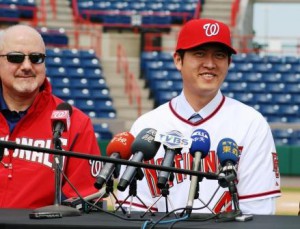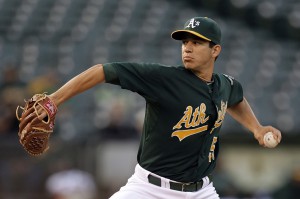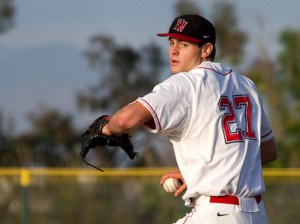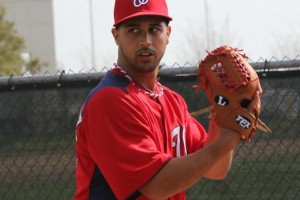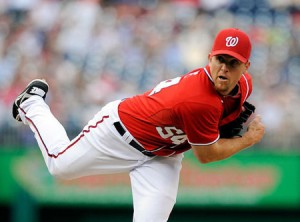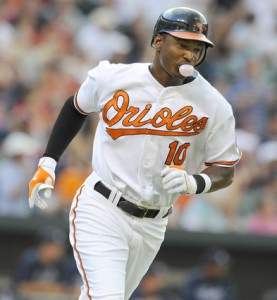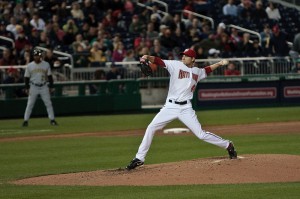
The return of Michael Morse has energized the offense. Photo Jacqueline Martin via federalbaseball blog
(Editor note; I attempted to publish this last Friday, then the server immediately went down all weekend. Wanted to re-post it to get commentary from typical readers. All numbers below were as of last friday, before the wild 4-game series against Atlanta).
There’s been lots of press this week, and to an extent all season, about Stephen Strasburg‘s innings limit. Mike Rizzo came out this week and said (paraphrasing) that there’s not a hard-and-fast 160ip limit, but that he will be shut down, and it will be Rizzo’s decision when Strasburg doesn’t pass the “eye test.”
Nats pundits are already discussing this impact on a playoff race, who the replacement may be (with John Lannan getting an early audition during this weekend’s double header), and whether we should flip someone out of our “thinned” farm system for a rental SP like Zack Greinke or Ryan Dempster (I put “thinned” in quotes out of deference to those that don’t share my glass-is-half empty opinion on the state of our farm system right now as posted here earlier this week).
Inarguably, this team will be a worse team without Strasburg. We’d be weaker in September once he got shut-down and we’d be hampered in a short series without our staff Ace. I’m not worried about September though; remember last year? Some teams were fielding 40-man roster specials, with lineups that mostly started the year in AAA. And I’m not entirely worried about how we’d look in a playoff series, since playoff rotations go 4 deep (meaning whatever question mark we’re throwing out there as a 5th starter in September is in the bullpen in October), and a rotation of Gonzalez, Zimmermann (who, amazingly, is tied for the NL lead in pitcher bWAR right now), Jackson and Detwiler getting the game 4 start is still pretty durn good.
But, here’s some interesting stats that should give you (and anyone in baseball frankly) some pause; this team is positioned to get significantly better from here on out, despite the looming loss of Strasburg and despite the fact that they’re already in first place. Why?
Because the offense is really starting to heat up.
Here’s some stats to give context: based on the Team Scoring page at baseball-reference.com, here’s the Nats scoring-based records:
- When the Nats score 0,1,2 or 3 runs, they are 14-28, for a .333 W/L percentage. This is pretty common; even last year’s 102-win Philadelphia team rarely won when scoring 3 or fewer runs.
- When the Nats score 4 or more runs? They are 39-9 this season, a .795 W/L percentage.
- Taking this a step further, when the nats score 5 or more runs, they’re 29-6, a .828 W/L percentage.
(For context, a record of 100-62 equates to a .617 W/L percentage).
Perhaps the above states the obvious; most teams have pretty good records when they score a bunch of runs. For comparison sake’s, here’s the same analysis for the team with the best record in baseball, the Yankees:
- Scoring: 0,1,2,3 runs: 5-23 for a .178 W/L
- 4+ runs: 52-12, .813 w/l
- 5+ runs: 44-10, .815 w/l
The Yankees and their superior offense leads to a ton of wins once they get above 4-5 runs. The difference between the Yankees and the Nats is our current ability to win a pretty sizeable number of games when scoring 3 or fewer runs. This difficulty in winning close games and depending on bashing your way to victory has been a theme for the Yankees for a few years now, and is one of the reasons they have only won one World Series since 2000 despite being in the playoffs nearly every year (only one missed playoff appearance during that span). They are susceptable to getting shut down by a good rotation in a short series. But I digress…
Getting back to the theme of this post: Here’s a look at the monthly W/L records for the Nats, along with average Runs scored and Runs Allowed (through July 19th’s game):
| Month |
W/L |
W/L pct |
RS |
RA |
| April |
14-8 |
0.636 |
3.36 |
2.68 |
| May |
15-13 |
0.535 |
4.21 |
3.85 |
| June |
15-11 |
0.576 |
4.46 |
3.73 |
| July |
9-5 |
0.642 |
4.78 |
3.57 |
|
|
|
|
|
| season |
53-37 |
0.588 |
4.166 |
3.488 |
Look specifically at the average number of Runs Scored by this team. It is distinctly trending up; from 3.36 RS/game in April to a massive 4.78 RS/game so far in the month of July. That’s almost 1 and a half more runs they’re scoring a game right now as compared to April (when their 14-8 record was mostly on the backs of one of the best opening months of starting pitching seen in the Majors since the dead-ball era).
Some reasons for this outburst of runs?
- Ryan Zimmerman‘s cortisone shot on June 24th: he had a .589 OPS in June (which should have been even worse, but he finished the last week of June on a tear, going 11-32 with 5 extra base hits after getting his shot), but has a blistering 1.280 OPS so far in July.
- The top of the order stepping it up: Danny Espinosa is hitting .327 in July and Lombardozzi is hitting nearly as well.
- The resurgence of Roger Bernadina, hitting at a .375 clip so far in July and leading to the DFA of Rick Ankiel (my wife’s favorite player; I havn’t broken the news to her yet).
Meanwhile, the rest of the sluggers in the lineup (Harper, LaRoche, and Tyler Moore doing his best effort to prove scouting pundits wrong who thought he couldn’t hack it against MLB pitching) are for the most part churning along and providing pop in front of and behind the 3-4-5 hitters in the order.
And, this offense could only get better when Jayson Werth returns. Remember; he was quietly having a solid year at the plate, with an .810 OPS and a 121 OPS+. You insert Werth and suddenly this team is rock solid and full of power from position 2-7. You’d have to sacrifice Bernadina and Moore to the bench primarily, but they’re great insurance in case Werth’s wrist betrays him.
They’re averaging 4.78 runs a game, and on the season they’re 39-9 when they score 4 or more runs. That spells a pretty serious run I expect this team to make in the next month and a half, especially against a slate of opponents that are mostly .500 or below. Right now, sitting at 53-37 they’re on pace for a 95 win season … but, amazing as it is to say it, this team easily has the capability of reaching 100 wins if their offense continues its upward trend.
